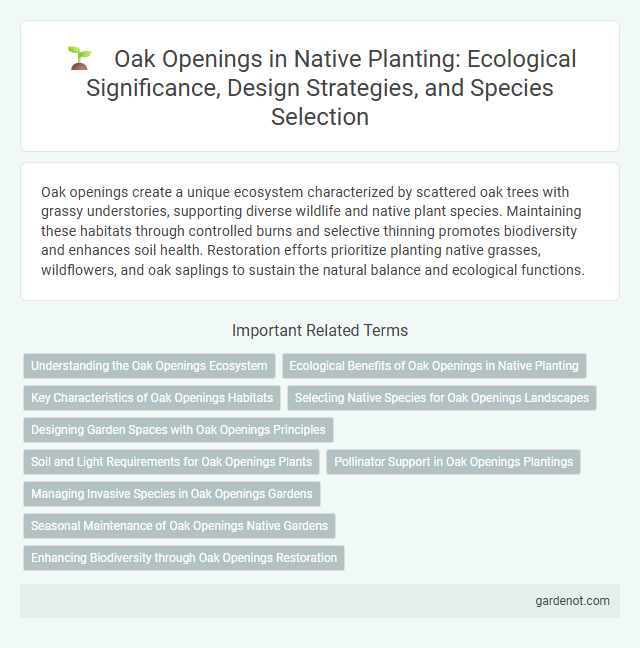Oak openings create a unique ecosystem characterized by scattered oak trees with grassy understories, supporting diverse wildlife and native plant species. Maintaining these habitats through controlled burns and selective thinning promotes biodiversity and enhances soil health. Restoration efforts prioritize planting native grasses, wildflowers, and oak saplings to sustain the natural balance and ecological functions.
Understanding the Oak Openings Ecosystem
The Oak Openings ecosystem is a unique blend of prairie, savanna, and woodland habitats supporting diverse native flora and fauna. Characterized by well-drained sandy soils and frequent fire regimes, this ecosystem promotes the growth of native oak species such as Bur oak and Black oak, essential for maintaining biodiversity. Understanding the complex interactions within Oak Openings helps guide effective native planting strategies to restore and preserve ecological balance.
Ecological Benefits of Oak Openings in Native Planting
Oak openings support biodiversity by providing diverse habitats for native flora and fauna, including rare oak savanna species and pollinators. These ecosystems enhance soil health through deep root systems that promote nutrient cycling and water infiltration. Maintaining oak openings contributes to carbon sequestration, helping mitigate climate change while preserving ecological balance.
Key Characteristics of Oak Openings Habitats
Oak openings habitats are characterized by a unique blend of widely spaced oak trees, primarily white oak (Quercus alba), allowing ample sunlight to reach a diverse understory of grasses and wildflowers. This ecosystem supports high biodiversity, including rare plant species and wildlife adapted to well-drained, sandy soils with periodic fire disturbances. The open canopy structure promotes a mix of prairie and woodland species, making oak openings critical for native plant conservation and ecosystem health.
Selecting Native Species for Oak Openings Landscapes
Selecting native species for Oak Openings landscapes enhances biodiversity, supports local wildlife, and preserves the unique prairie-savanna ecosystem. Key native plants include bur oak (Quercus macrocarpa), prairie dropseed (Sporobolus heterolepis), and shooting star (Dodecatheon meadia), all adapted to the region's well-drained, sandy soils and periodic fire regimes. Integrating these species fosters resilience, improves soil health, and maintains the ecological balance characteristic of Oak Openings habitats.
Designing Garden Spaces with Oak Openings Principles
Designing garden spaces using Oak Openings principles emphasizes the integration of native oak savanna ecosystems, prioritizing biodiversity and ecological resilience. Incorporating a variety of native oak species like bur oak (Quercus macrocarpa) and white oak (Quercus alba) supports wildlife habitat and promotes natural succession processes. Emulating the Oak Openings habitat involves strategic layering of grasses, wildflowers, and understory shrubs to create a sustainable, visually dynamic landscape that maintains soil health and native pollinator populations.
Soil and Light Requirements for Oak Openings Plants
Oak openings thrive in well-drained, sandy or loamy soils with moderate fertility, ensuring optimal root growth and nutrient uptake. These ecosystems require full sun exposure, as oak opening plants depend on abundant sunlight to sustain photosynthesis and maintain their competitive edge. Proper soil aeration and consistent light availability are critical for the successful establishment and health of native oak opening species.
Pollinator Support in Oak Openings Plantings
Oak Openings plantings create vital habitats that support diverse pollinator species, including native bees, butterflies, and moths. The rich diversity of flowering native plants in these ecosystems provides continuous nectar and pollen sources throughout the growing season, enhancing pollinator health and reproduction. Maintaining oak savanna and prairie remnants within Oak Openings landscapes strengthens ecosystem resilience by sustaining essential pollinator populations crucial for native plant reproduction.
Managing Invasive Species in Oak Openings Gardens
Managing invasive species in Oak Openings gardens is critical to preserving native biodiversity and ecosystem health. Effective strategies include early identification of species like garlic mustard and buckthorn, manual removal, and the application of targeted herbicides to prevent their spread. Restoration efforts often integrate native oak species and native understory plants to enhance resilience against invasive encroachment.
Seasonal Maintenance of Oak Openings Native Gardens
Seasonal maintenance of Oak Openings native gardens involves timely mowing and controlled burns to manage invasive species and promote native plant growth. Regular monitoring of plant health and soil moisture during spring and fall ensures optimal conditions for oak savanna species to thrive. Proper removal of debris and selective pruning support biodiversity and enhance habitat quality throughout the growing season.
Enhancing Biodiversity through Oak Openings Restoration
Oak openings restoration revitalizes native ecosystems by reestablishing open savanna habitats dominated by native oak species such as Quercus alba and Quercus velutina, which support a rich diversity of flora and fauna. Restoring these habitats increases sunlight penetration and soil quality, encouraging growth of native understory plants and providing critical resources for pollinators, birds, and small mammals. Biodiversity enhancement through oak openings restoration contributes to ecosystem resilience and helps preserve regional genetic diversity crucial for climate adaptation.
Oak opening Infographic

 gardenot.com
gardenot.com